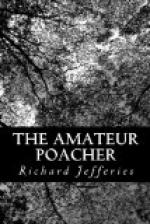CHAPTER XI
FERRETING: A RABBIT-HUNTER
The ferreting season commences when the frosts have caused the leaves to drop, and the rabbits grow fat from feeding on bark. Early one December morning, Orion and I started, with our man Little John, to ferret a double-mound for our old friend Farmer ‘Willum’ at Redcote.
Little John was a labourer—one of those frequently working at odd times for Luke, the Rabbit-Contractor. We had nicknamed him Little John because of his great size and unwieldy proportions. He was the most useful man we knew for such work; his heart was so thoroughly in it.
He was waiting for us before we had finished breakfast, with his tools and implements, having carefully prepared these while yet it was dark at home in his cottage. The nets require looking to before starting, as they are apt to get into a tangle, and there is nothing so annoying as to have to unravel strings with chilled fingers in a ditch. Some have to be mended, having been torn; some are cast aside altogether because weak and rotten. The twine having been frequently saturated with water has decayed. All the nets are of a light yellow colour from the clay and sand that has worked into the string.
These nets almost filled a sack, into which he also cast a pair of ‘owl-catchers,’ gloves of stout white leather, thick enough to turn a thorn while handling bushes, or to withstand the claws of an owl furiously resisting capture. His ferrets cost him much thought, which to take and which to leave behind. He had also to be particular how he fed them—they must be eager for prey, and yet they must not be starved, else they would gorge on the blood of the first rabbit, and become useless for hunting.
Two had to be muzzled—an operation of some difficulty that generally results in a scratched hand. A small piece of small but strong twine is passed through the jaws behind the tusk-like teeth, and tightly tied round, so tightly as almost to cut into the skin. This is the old way of muzzling a ferret, handed down from generations: Little John scorns the muzzles that can be bought at shops, and still more despises the tiny bells to hang round the neck. The first he says often come off, and the second embarrass the ferret and sometimes catch in projecting rootlets and hold it fast. He has, too, a line—many yards of stout twine wound about a short stick—to line a ferret if necessary.
The ferrets are placed in a smaller bag, tightly tied at the top—for they will work through and get out if any aperture be left. Inside the bag is a little hay for them to lay on. He prefers the fitchew ferret as he calls it; that is the sort that are coloured like a polecat. He says they are fiercer, larger of make and more powerful. But he has also a couple of white ones with pink eyes. Besides the sack of nets, the bag of ferrets, and a small bundle in a knotted handkerchief—his ’nuncheon’—which in themselves make a tolerable load, he has brought a billhook, and a ‘navigator,’ or draining-tool.




